Exploring Crystals Inside Geodes
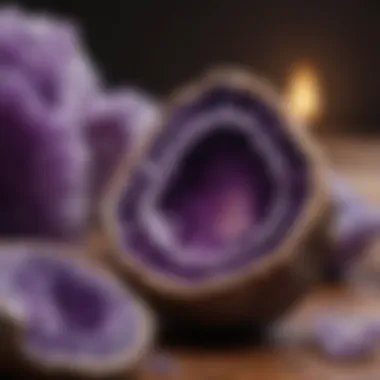
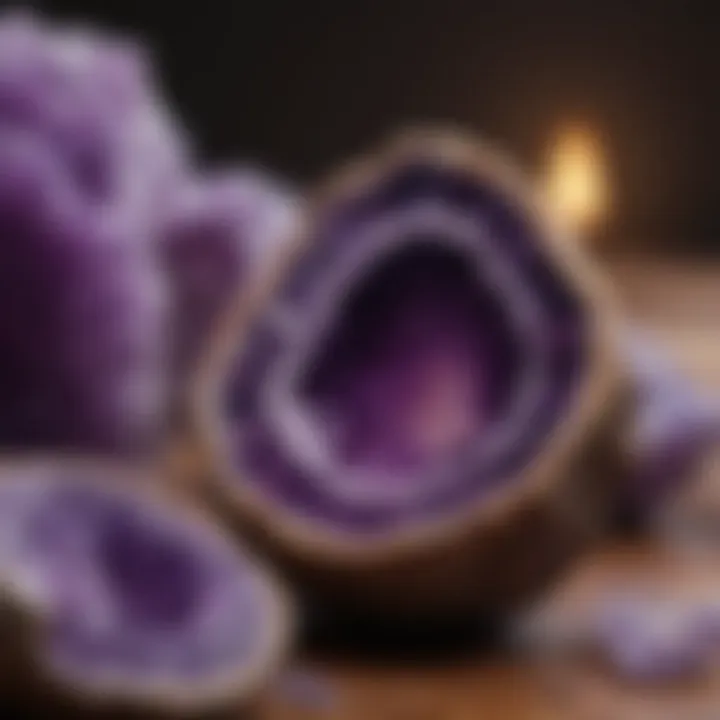
Intro
Geodes are like nature's little puzzle boxes. You crack one open, and you're greeted by a sparkling interior, revealing crystals that may have taken millions of years to form. It's a fascinating intersection of geology and artistry—not just a rock or mineral, but a time capsule of Earth's history. These intriguing formations spark curiosity among rock collectors and hobbyists alike. So, what can you expect to find when you break open a geode? Let's embark on an exploration of the types of crystals that reside within these geological wonders, aiming to enhance your appreciation and collection of geodes.
Featured Collectible of the Month
Overview
This month, our spotlight shines on the amethyst geode, a striking specimen that captures the attention of collectors far and wide. This purple variety of quartz is not just visually stunning; it also carries intriguing stories and characteristics worth discussing.
Historical Significance
The use and admiration of amethyst stretch back to the ancient civilizations of Greece and Egypt, where it was believed to hold protective and healing properties. Amethyst was so valued that it adorned the crowns of kings and high officials. These historical ties add a layer of depth to the appreciation of amethyst geodes today. Collectors not only obtain a beautiful specimen but also a piece of history that resonates with ancient beliefs and cultural significance.
Identification Techniques
Identifying the crystals inside your geode is a vital step for any collector. Understanding how to distinguish between them can significantly enhance your collection experience. Here are some effective techniques to help you identify the treasures within.
Visual Characteristics
- Color: The hue can vary greatly. For instance, the rich purples of amethyst contrast sharply with the milky whites of quartz or the deep reds of garnets.
- Clarity: Clear crystals are usually quartz, while opaque varieties could be agate. Examining clarity can offer clues about the type of crystal present.
- Shape: From pointed terminations in quartz crystals to rounded formations of calcite, the shape can be a telling factor.
- Size: The size of individual crystals inside the geode can vary, affecting how they interact with light and color perception.
Resources for Identification
Several tools and resources can aid you in identifying the crystals in your geode:
- Books: Publications focused on mineral identification can provide detailed photographs and descriptions. A favorite among enthusiasts is The Audubon Society Field Guide to North American Rocks and Minerals, which includes color photos and concise descriptions.
- Online Forums: Websites like reddit.com host communities where you can share photos of your geodes and get insights from seasoned collectors.
- Local Gem Shows: Visiting gem and mineral shows offers a chance to connect with experts who can assist with identification.
- Social Media Groups: Platforms such as facebook.com offer numerous groups focused on mineral collections where members can share their knowledge.
"Identifying crystals in your geode isn't just about knowing what they are; it's about connecting with a piece of Earth's incredible narrative."
Keep these techniques and resources in mind as you navigate the fascinating world of geodes and crystals. The varied beauty and complexity contained within these geological forms are waiting to be discovered, and understanding their characteristics will enhance both your appreciation and enjoyment of this hobby.
Preface to Geodes
Understanding geodes is crucial for enthusiasts and collectors alike. These fascinating formations act like nature's little time capsules, preserving a history of geological activity. Delving into the aspects of geodes contributes to a deeper appreciation of the crystals that reside within them and the processes that create these astonishing structures. The beauty and mystery they hold spark curiosity, encouraging further exploration in geology.
Definition and Characteristics
Geodes are hollow rock formations, often lined with beautiful crystals that develop over time. They typically appear as unassuming, rough nodules, but once cracked open, reveal their stunning internal beauty. A geode’s exterior is often composed of a hard layer of mineral, most commonly chalcedony, hiding the various crystal structures inside.
Characteristics that define a geode include:
- Shape: Unlike other mineral formations, geodes are typically spherical or oval, creating that perfect cavity for crystal growth.
- Formation Process: They form when mineral-rich water fills a cavity in sedimentary rock, eventually crystallizing as conditions change.
- Internal Features: The interior may showcase anything from quartz and amethyst to calcite and agate, presenting a unique tapestry of colors and forms.
The Geological Context of Geodes
Geodes are more than just pretty minerals; they tell a story of geological conditions. Most commonly, geodes emerge from volcanic or sedimentary environments. As magma cools, gas bubbles can create cavities—perfect spots for crystal growth. They can also arise from the weathering of rocks in sedimentary deposits, which allows mineral-rich fluids to seep in.
The geological significance includes:
- Temporal Evidence: They can indicate the specific environment and conditions present during their formation.
- Indicator of Mineralization: The presence and type of crystals within a geode can suggest local mineral deposits, potential mining sites, or areas rich in specific geologic events.
"Geodes are not just captured crystals; they're ancient stories of our planet unfolding through time."
Collecting geodes offers not just physical specimens but also a connection to the Earth's dynamic processes. By understanding their definition and geological background, enthusiasts can summon a newfound respect for the natural world and its intricate history.
Common Types of Crystals Found in Geodes
Understanding the common types of crystals found in geodes is central to any collector or enthusiast's journey into the captivating world of geology. Not only does this knowledge enhance one’s appreciation of these unique formations, but it also aids in identification and categorization. Geodes are not simply decorative; they tell a story of their geological formation and can offer insights into the environmental conditions at the time. Identifying different crystal types in geodes allows collectors to uncover their origins, which is beneficial for personal collection records and educational purposes.
Quartz Crystals
Formation Process
The formation process of quartz crystals in geodes is quite fascinating. Typically, quartz forms when silica-rich solutions seep into empty cavities and precipitate as the solution cools or evaporates. The temperature and pressure play crucial roles in determining the crystal's size and clarity. This specific formation process is vital to understanding how quartz is found in geodes and its appeal as a sought-after crystal. One significant characteristic of quartz formation is its ability to occur in various environments, from volcanic to sedimentary rocks. Such versatility makes it popular among collectors and hobbyists alike. Notably, larger quartz crystals often form in environments where space is ample for growth, giving them that stunning, elongated appearance that many treasure.
Varieties of Quartz
Within the realm of quartz, numerous varieties exist, each bringing its unique charm. Common varieties such as amethyst, citrine, and smoky quartz differ primarily in color and trace elements present during formation. The unique feature of these varieties lies not just in their aesthetics but also in their metaphysical properties, which many collectors find appealing. For instance, amethyst is often associated with tranquility, while citrine is linked to abundance. This variety makes it a beneficial topic for collectors as understanding the type of quartz they possess can directly affect the value and significance of their collection. Furthermore, knowing the varieties can enhance one's appreciation for their distinct qualities.
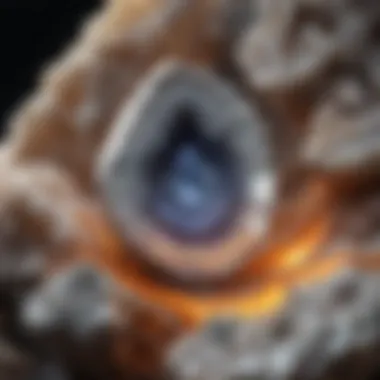
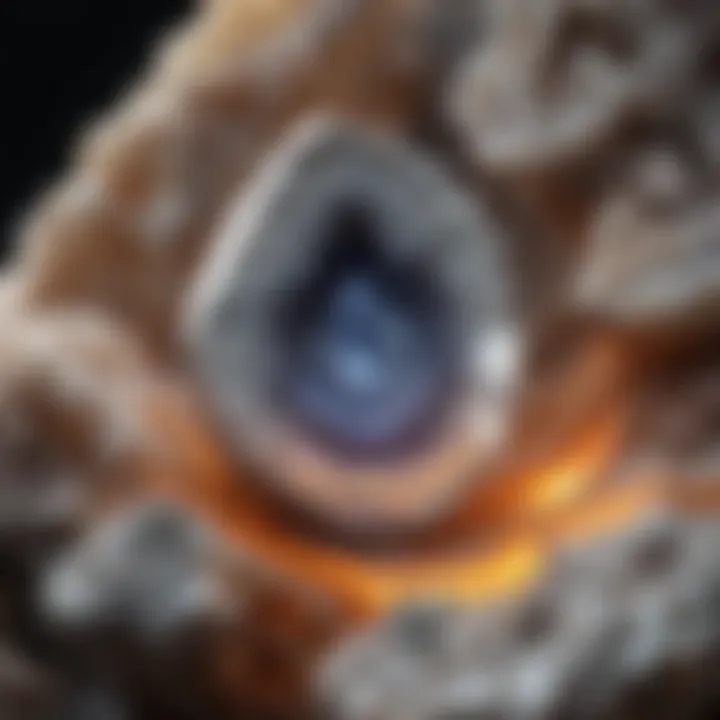
Physical Properties
Focusing on the physical properties of quartz is essential, as they contribute significantly to its identity. Quartz is known for its hardness, rated a 7 on the Mohs scale, making it resistant to scratches and wear. This durability is a key characteristic, making quartz a favorite among collectors who want long-lasting specimens. Additionally, quartz displays a fascinating phenomenon known as piezoelectricity, where it can generate an electric charge under pressure. This unique property opens avenues for various applications beyond mere aesthetics, illustrating why quartz deserves recognition.
Calcite Crystals
Formation Mechanisms
Calcite, another prominent crystal found in geodes, has unique formation mechanisms. Often forming through the precipitation of calcium carbonate, it can dissolve and re-crystallize in various geological environments. This flexibility in formation makes calcite an interesting subject for collectors aiming to deepen their understanding of mineralogy. The ability of calcite to form in different shapes, like rhombohedra or scalenohedra, enhances its appeal. Each shape offers something different, making it a popular choice for collectors, and understanding these mechanisms adds depth to the collector's knowledge.
Distinctive Features
Calcite crystals can be easily identified by their distinctive features, such as their excellent cleavage properties and wide range of colors and transparency. This characteristic makes calcite both visually appealing and scientifically relevant. It's fascinating how the way light interacts with calcite, causing it to fluoresce under certain conditions, can captivate a collector's interest. Moreover, the presence of impurities can lead to a plethora of color variations, presenting collectors with a diverse array of specimens to choose from.
Common Occurrences
When discussing common occurrences, calcite is often found in sedimentary rock formations and hydrothermal veins. These environments contribute to the widespread availability of calcite crystals. Collectors often appreciate this accessibility, as it allows for a richer collection experience without needing to travel far. However, caution must be taken, as not all calcite specimens are created equal; some may exhibit less desirable physical properties or aesthetic imperfections.
Amethyst Crystals
Characteristics of Amethyst
Amethyst is perhaps among the most beloved of all crystals found in geodes, famed for its rich purple hues and beauty. Its formation is often tied to volcanic activity, where silica-containing fluids cool down in geodes. The key characteristic of amethyst is its distinct coloration, caused by iron impurities and natural radiation. This appealing quality makes it a favored choice for collectors, drawing them not only for its beauty but its lore as a stone of balance. However, the market is flooded with artificially treated stones, making identifying genuine amethyst crucial for collectors.
Color Variations
Color variations in amethyst extend beyond just deep purple. You can find shades ranging from almost colorless to dark violet, resulting from differing concentrations of iron and the length of exposure to radiation. This aspect makes amethyst an exciting choice for collectors who wish to showcase a spectrum of hues in their collection. The uniqueness of each piece, with its color gradients, makes it a distinct specimen in any collection. Notably, lighter shades may be less valuable but still hold aesthetic charm, adding to the richness of the collecting experience.
Key Locations
Geologically, amethyst is found in robust deposits worldwide. Regions such as Brazil, Uruguay, and Zambia are renowned for their high-quality amethyst. Collectors often seek specimens from these areas, not just for their quality but also for the stories they tell. Understanding where your amethyst hails from can add context to your collection and potentially increase its value. Additionally, each source may offer crystals with specific characteristics that differ from one another.
Other Notable Crystals
Citrine
Citrine, a yellow to brownish variant of quartz, is another notable crystal found in geodes. Its warm hue makes it a favorite among collectors seeking to add a splash of color to their collections. One key trait of citrine is its tendency to mimic the properties of amethyst, which can sometimes lead to confusion. However, it is less prone to heat treatments than amethyst, giving collectors confidence in its authenticity. Plus, the metaphysical properties claimed by supporters directly relate to abundance, making this crystal appealing for those looking for positive energies in their collection.
Agate
Agate often presents in geodes as a banded stone with intricate patterns. This unique characteristic offers a visual feast for collectors, as no two agates are alike. Known for its versatility, it can be processed into jewelry and decorative items, allowing collectors to enjoy its beauty in various forms. While agate’s beauty is evident, it also offers combinational rarity, making certain specimens more coveted. Collectors often seek to identify those rare formations, encompassing everything from moss agate to lace agate.
Celestite
Celestite, known for its delicate blue crystals, can occasionally be found in geodes. Its light color and crystalline form give it an ethereal quality that appeals to many collectors. One of the defining features of celestite is its relatively low hardness, measuring around 3 on the Mohs scale, which requires special care in handling. The blue hue results from the presence of strontium, and understanding this can assist collectors in identifying genuine pieces. Despite its more delicate nature compared to quartz or calcite, cutting or shaping celestite opens up beautiful options for display within a collection.
Identifying Crystals within Your Geode
Identifying the specific crystals within your geode is a vital step in understanding its overall beauty and geological significance. This process not only satisfies curiosity but also enhances the appreciation of your geological findings. Recognizing different crystals can lead to more informed decisions, whether you plan to collect, display, or study them further. Evaluating crystal types can also provide insight into the geode's formation history and the environmental conditions present during its development. This is where observation and analysis come into play, playing a crucial role in enriching your journey as a rock collector.
Visual Inspection Techniques
Visual inspection is the initial approach many collectors use when trying to identify the crystals within their geodes. This method involves carefully examining the exterior and the interior surfaces of the geode. You might want to look for distinctive features, such as color variations, texture, and crystal shapes. For instance, while some crystals have a glassy sheen, others may present a dull or matte finish. The use of bright lighting can enhance these particular features, allowing subtler nuances to come to light.
Moreover, the arrangement of the crystals can provide clues about their identity. Some may cluster densely, while others might form well-defined geometric patterns. Keep in mind, however, that some characteristics can be misleading. Therefore, combining visual inspection with other identification methods is generally recommended to avoid jumping to conclusions based on initial findings alone.
Utilizing Tools for Identification
When the naked eye just isn't enough, employing tools designed for crystal identification can be incredibly beneficial.
Loupes and Magnifying Glasses
Loupes and magnifying glasses serve as valuable aids in enhancing your visual inspection. These handy tools allow for a closer look at the intricate details of the crystals, which often go unnoticed without magnification. The key characteristic of these tools is their ability to magnify the crystal surfaces, revealing additional layers of detail, such as growth patterns and inclusions. This could help differentiate similar-looking crystals.
One unique feature of loupes, for example, is their compact design, making them easily portable—perfect for collectors on the move. However, it's essential to remember that using them requires a steady hand and requires practice to get a clear view.
Field Guides and Charts
Field guides and identification charts are indispensable resources for anyone aspiring to become proficient in crystal identification. These guides typically include images, descriptions, and information about various minerals, making them incredibly user-friendly. A remarkable aspect of these guides is that they come in various formats, whether printed or digital, catering to different preferred methods of studying.


The unique feature of field guides is that they often present localized information, helping you identify crystals based on regional geology. Still, it's crucial to remember that no guide is exhaustive. One may find unexpected varieties that don’t match any provided descriptions, so treating these guides as guiding tools rather than definitive sources is wise.
Testing for Hardness
Testing crystal hardness using the Mohs scale is another objective method for identification. This technique evaluates a crystal's resistance to scratching, providing clear indications of its identity. The key characteristic of hardness testing is its quantitative nature, allowing collectors to compare their crystals directly against the hardness of known minerals.
Using a simple scratch test, you can identify the hardness relative to household items or specialized tools. Some common minerals, like talc, have a hardness of 1, while diamonds score a 10. A distinct advantage of this method is its simplicity, but it does require caution; scratching can damage your crystal. Therefore, it is best used when you are still within the exploration phase rather than on prized specimens.
By employing these techniques and tools, you will enhance your ability to identify the crystals within your geode confidently. Remember to document your findings, as this record will be invaluable in the future, not just for your personal reference but also when sharing experiences with fellow enthusiasts.
The Formation Process of Crystals in Geodes
Understanding the formation process of crystals in geodes is crucial for anyone interested in the world of geology and crystal collection. It does more than just explain how those stunning crystals come to life; it dives into the elements that contribute to their unique beauty and structure. Geodes can be a treasure trove of information that speaks volumes about the geological history of our planet. Knowing how crystals develop not only enhances your appreciation but can directly influence how you approach your collection strategy.
Understanding Mineral Deposition
Mineral deposition is the first step in the crystal formation process. It occurs when mineral-rich solutions enter a cavity in a rock, often a bubble formed by volcanic activity. Over time, as the solution cools and evaporates, minerals precipitate out and begin to accumulate on the walls of the cavity.
Factors that influence mineral deposition include:
- Solution concentration: A higher concentration of minerals leads to more rapid crystal growth.
- Availability of space: The cavity size determines how crystals can develop; a large space allows for larger crystals.
- Flow of the solution: More movement in the solution can lead to varied crystal forms as different minerals mix and separate.
Each of these elements contributes to the distinctive characteristics that crystals inside geodes will ultimately exhibit. This is why similar-looking geodes can yield remarkably different internal landscapes, each telling a different story of its formation.
"The beauty of a geode lies not just in its exterior but in the tale it tells through its crystal formations."
Influence of Temperature and Pressure
Temperature and pressure vary widely within the geological layers of Earth where geodes form. These two factors are essential for shaping not only the types of crystals that develop but also their size and clarity. Generally, as temperature increases, chemical reactions proceed faster, enabling quicker crystal growth. Conversely, lower temperatures tend to slow down these processes, resulting in different mineral formations.
Moreover, high pressure can also enhance the rate of crystal formation. Take, for instance, quartz geodes, where the combination of heat and pressure creates beautiful, perfectly aligned quartz crystals that reflect light in myriad ways.
Key points to consider:
- Thermal stability: Fluctuations in temperature can impact how uniformly the crystals grow.
- Pressure variations: Higher pressures generally lead to denser crystal structures, making them more resilient and often more striking.
Understanding how temperature and pressure interact can be pivotal when examining your geode. These elements serve as indicators of the environment in which the crystals formed, adding another layer of depth to your collecting experience.
Extraction Methods for Geodes
Extracting geodes requires a certain finesse, much like a dance between patience and precision. This process requires a blend of knowledge, well-chosen tools, and a serious commitment to safety, all aimed at preserving the beautiful crystals within these unique geological formations. Extracting a geode not only opens a window into its hidden treasures but also enhances the appreciation for their natural beauty. Knowing how to do it safely and effectively can turn what could be a chaotic venture into a rewarding experience.
Best Practices for Safe Extraction
When embarking on the journey to extract crystals from a geode, it’s crucial to follow best practices that ensure both safety and success. First and foremost, understanding the geological context of where you're working is vital. One must inspect the surrounding environment for any loose debris or unstable rock formations that could pose risks while extracting the geode.
Furthermore, patience is key. Hastiness can lead to unwanted accidents. It’s wiser to chip away slowly at the geode rather than taking large swings that might break the crystals inside, which is often the goal. Always aim for the side that seems less likely to be housing valuable crystals or simply would mean less impact. Taking notes on successful methods used can provide an excellent reference for future excursions.
Tools Required for Geode Extraction
Hammers and Chisels
Using hammers and chisels is the bread and butter of geode extraction. These tools are indispensable for the task, as they allow you to carefully break the outer shell of the geode without obliterating its crystalline interior. A flat-headed chisel is often preferred for its ability to deliver efficient force while also providing more control during the process. This characteristic makes it a versatile tool in the extraction toolkit.
However, one must be cautious about the type of hammer used. A hammer that's too heavy can result in damaging the treasures inside. Many collectors favor a sledgehammer for larger geodes but pair it with a smaller hammer for finer control when making initial taps. The unique combination of both tools ensures not only effective extraction but also significantly reduces the risk of mishaps.
Safety Gear
When smashing rocks, safety gears is crucial for personal protection. Goggles should be the first item on any collector's list since flying rock pieces can cause serious injuries. A sturdy pair of gloves is also a must, protecting hands from sharp edges and accidental strikes. Furthermore, wearing closed-toe shoes can help prevent injuries from dropped tools or debris.
The use of safety gear is a wise recommendation that enhances an individual’s ability to work carefully and efficiently. This characteristic of preparedness not only ensures a smoother extraction process but can also save one's hands or eyes from potential harm during the sometimes unpredictable activities of geode cracking.
Protective Measures
In addition to individual safety gear, it’s always smart to implement protective measures while extracting geodes. Ensure that the site is free from distractions and that enough space is available to maneuver without accidents. Establishing a safe perimeter around the extraction zone is a smart practice, especially when working with friends or fellow collectors.
Another protective measure to consider is the use of a tarp or something similar to catch debris. This not only keeps the area clean but also decreases the likelihood of losing small crystal fragments that may fly off during the process. Additionally, maintaining a cool head and being aware of your surroundings — as easy as that sounds — is an underrated yet advantageous tactic.
Remember: Safety is not just a precaution; it’s a priority. Taking the right steps in preparation can drastically enhance both the enjoyment and outcome of your extraction journey.
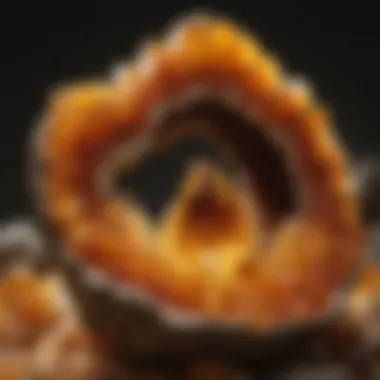
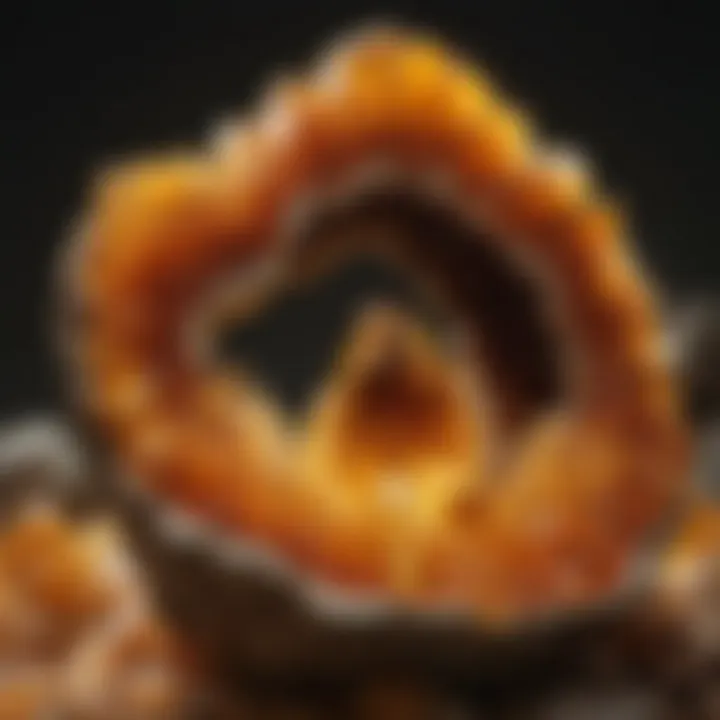
Care and Preservation of Geodes and Crystals
Taking care of geodes and their crystalline inhabitants goes beyond just keeping them clean. Proper maintenance enhances their visual appeal and assists in preserving their geological integrity. Just like giving a classic car a good polish keeps it looking sharp, maintaining your geode collection ensures that these stunning geological marvels can be appreciated for years to come.
Cleaning Crystals Safely
When it comes to cleaning geodes and their crystals, the gentle touch is key. Many of the beautiful formations inside can be delicate; a wrong move could chip or scratch their surfaces.
- Gentle Washing: Using distilled water is often recommended, as tap water can contain minerals that might precipitate and stain the crystals. Simply rinse the crystals under lukewarm water, using a soft brush to remove any dirt or residue.
- Avoid Harsh Chemicals: Chemicals can ruin the patina of crystals and geodes. A mixture of mild soap and water can suffice.
- Drying: After cleaning, let the crystals air dry on a soft cloth. Avoid exposing them to direct sunlight, which can cause abrupt temperature changes and potential damage.
Best Storage Practices
Storing geodes and crystals correctly ensures that they remain intact and visually stunning.
Humidity Control
Humidity plays a pivotal role in preserving the authenticity of geodes. Geodes thrive best in conditions that mimic their natural habitat.
- Optimal Range: A humidity level around 40-60% is often ideal. Too much moisture can promote mold growth, while too little can lead to cracks and other damage.
- Benefits: Maintaining this balanced humidity helps to protect fragile crystals from deterioration. It's a smart choice for collectors who want their specimens to retain both their beauty and value.
- Unique Features: Investing in a hygrometer can provide direct readings and help manage environmental conditions effectively. It’s a small, beneficial addition to any collector's toolkit, making sure the crystals stay as pristine as possible.
Temperature Considerations
Temperature stability is another important factor. Just as you wouldn’t want your ice cream to melt, the same applies to your geodes.
- Stability: A stable temperature, ideally around room temperature (20-22°C), can help avoid thermal shock in crystals, preventing fractures.
- Benefits: Temperatures that fluctuate too greatly can lead to cracks in fragile species; keeping them consistently at room temperature helps prevent this from happening.
- Unique Feature: Utilizing insulated display cases can help in minimizing temperature changes, creating a controlled environment that extends the life of your geodes.
Display Techniques
How you display your geodes can also significantly impact their preservation and appearance.
- Support and Stability: Use appropriate stands or padding to support the weight of the geodes. They shouldn’t be placed where they can fall or be bumped into, which might cause damage.
- Visibility: Placing geodes in well-lit but indirect sunlight showcases their colors and textures without risking fading or damaging them due to excess UV exposure.
- Rotation: Regularly rotating display pieces can keep them from becoming too dusty or monotony setting in. Just be careful to maintain their orientation as dropping pieces can lead to fracturing or chipping.
"Preserving the delicate beauty of geodes is not merely an act of care, but a respectful nod to the natural wonders they embody."
By understanding the critical elements of care and preservation, hobbyists and collectors can foster a nurturing environment for their prized specimens. This not only enhances their collection experience but also contributes to a deeper appreciation of geodes as remarkable geological structures.
Connecting Geodes to Broader Geological Themes
Understanding geodes goes beyond mere visual wonderment; it provides an insightful glimpse into Earth’s geological processes. This section explores how these fascinating structures fit into the bigger picture of geology, shedding light on various significant aspects.
Geodes in Historical Context
Geodes have been around for millions of years, often providing an open window into the Earth’s storied past. When you slice open a geode, it’s like flipping through a history book where each layer reveals secrets of ancient environments, volcanic activity, and mineral deposits. Paleontologists and geologists alike study these structures to gain insights into Earth’s formative years. They tell tales of past climate, tectonic movements, and even the presence of life on Earth at different epochs.
Throughout human history, numerous civilizations have utilized crystals from geodes for more than just decoration; ancient Egyptians prized lapis lazuli, which formed similarly, for its striking hue and spiritual significance. Additionally, evidence suggests that geodes have been exchanged as trade goods among ancient cultures, emphasizing their value not only as natural artifacts but as pieces of history that span across continents and epochs.
"Geodes serve as nature's time capsules, each crystal a whisper from the past."
Cultural Significance of Geodes
Geodes are not merely geological specimens; they've woven themselves into the fabric of various cultures around the globe. For instance, in some Native American traditions, geodes symbolize purity and healing. The clear quartz crystals often believed to possess protective and energizing properties have found a place in ceremonies and rituals, underlining their spiritual significance.
In modern times, rock and mineral collectors view geodes as gateways into a deeper appreciation of Earth. The act of finding and breaking open a geode encourages curiosity and reverence for nature—qualities that resonate with enthusiasts and novices alike. Collectors often share their findings on platforms like Reddit and Facebook, where they debate the crystal’s attributes and geography of origin, further enriching the communal experience surrounding geodes.
Moreover, the artistic expression found in geode formations can be seen in home décor, jewelry designing, and even fashion, showcasing how these natural wonders have transcended their geological roots to find places in contemporary life. By connecting these exquisite stones to their cultural implications, one doesn't merely collect a rock; they gather stories, beliefs, and art—a true testament to the multifaceted relationship between humanity and nature.
Ending
Understanding the world of geodes and the crystals contained within them enriches one’s appreciation for geology and its many layers of complexity. As we sifted through the details of this article, we delved into identifying crystals, their formation processes, and methods to extract and care for these geological wonders.
Summary of Key Points
- We explored the various types of crystals, focusing on Quartz, Calcite, and Amethyst, each possessing unique formation traits and visual characteristics.
- In the section on identification techniques, we highlighted the significance of visual inspections and the role of tools like loupes and field guides.
- Safety in extraction and preservation was a recurring theme, ensuring hobbyists can enjoy their collecting pursuits without damaging their specimens.
Furthermore, geodes hold not only aesthetic value but also cultural and historical significance, as dissected in the broader geological themes chapter. Recognizing these aspects allows collectors to appreciate their findings beyond mere beauty.
"The beauty of a geode lies in its hidden treasures, waiting to be unveiled by those patient enough to embrace the journey of exploration."
Encouragement for Continued Exploration
The adventure doesn’t end with the knowledge gained from this article. The world of geodes and crystals is vast and multi-faceted. For those intrigued, more exploration awaits!
- Visit local rock shops or gem shows to expand your collection and learn from fellow enthusiasts.
- Joining online platforms like reddit.com allows you to connect with other collectors and share your experiences and discoveries.
- Further research on geodes can lead you to hidden gems, so to speak – geological sites known for their unique crystal formations.
Inspire curiosity and deepen your understanding, whether by examining specimens under a microscope or participating in community discussions. The journey into the geological world of geodes promises both learning and excitement for years to come, reaffirming that every geode has its own story just waiting to be told.



